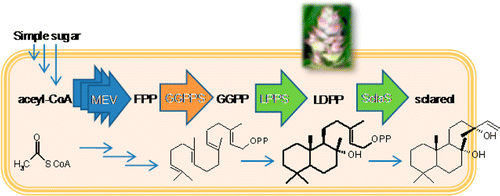Sustainable way to make a prized fragrance ingredient

Large amounts of a substitute for one of the world's most treasured fragrance ingredients—a substance that also has potential anti-cancer activity—could be produced with a sustainable new technology, scientists are reporting. Published in the Journal of the American Chemical Society, the advance enables cultures of bacteria to produce a substitute for natural ambergris, which sells for hundreds of dollars an ounce.
Laurent Daviet, Michel Schalk and colleagues explain that ambergris, a waxy substance excreted by sperm whales, has been prized as a fragrance ingredient for centuries. Ambergris has a pleasant sweet and earthy scent of its own, and it enhances other scents in high-end perfumes. With sperm whales an endangered species, and natural ambergris not used in perfumes in the U.S., perfume makers have turned to substitutes. One is made from sclareol, obtained from the Clary sage plant. But the plant contains only small amounts of sclareol, and it is laborious to extract and purify. That's why the scientists looked for a better way of making large amounts of sclareol.
Their report describes isolating the genetic material (DNA) that produces the two Clary sage enzymes needed to make sclareol. They put the DNA into bacteria, which made large amounts of sclareol in bioreactors.
More information: Toward a Biosynthetic Route to Sclareol and Amber Odorants, J. Am. Chem. Soc., 2012, 134 (46), pp 18900–18903. DOI: 10.1021/ja307404u
Abstract
Ambergris, a waxy substance excreted by the intestinal tract of the sperm whale, has been a highly prized fragrance ingredient for millenia. Because of supply shortage and price inflation, a number of ambergris substitutes have been developed by the fragrance industry. One of the key olfactory components and most appreciated substitutes of ambergris, Ambrox is produced industrially by semisynthesis from sclareol, a diterpene-diol isolated from Clary sage. In the present study, we report the cloning and functional characterization of the enzymes responsible for the biosynthesis of sclareol. Furthermore, we reconstructed the sclareol biosynthetic pathway in genetically engineered Escherichia coli and reached sclareol titers of 1.5 g/L in high-cell-density fermentation. Our work provides a basis for the development of an alternative, sustainable, and cost-efficient route to sclareol and other diterpene analogues.
Journal information: Journal of the American Chemical Society
Provided by American Chemical Society


















